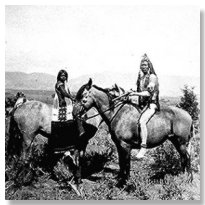History of Utah County
It will be remembered with what reluctance the Timpanogas Indians who met the Higbee colony in March, 1849, permitted the first white settlement on Provo River, and that, too, in spite of the invitation previously extended to the colonists by the chiefs, Sowiette and Walker, to settle among their tribes and teach them how to become civilized. It has also been stated that soon after Fort Utah was founded, Walker, according to Colonel Bridger and Mr. Vasquez, began stirring up the Indians against the Mormon settlers. In this movement Walker was aided by another chief named Elk, - variously styled Big Elk, Old Elk, etc., - like himself a hater of the whites, and apparently quite as fond of fighting. It was with Big Elk and his band that the Provo settlers, in their first regular battle with the savages, had immediately to deal.
History of Utah by Orson F. Whitney
Volume 1
Chapter XXII 1849 - 1851
Native Peoples

The Timpanogos Utes or Utah Valley Utes inhabited the valley using American Fork Canyon to hunt big game and gather berries.
The Utah "Black Hawk War" (9 April 1865 -1898) erupted as a result of the pressures white expansion brought to Native American populations. White settlement of Utah altered crucial ecosystems and helped destroy Indian subsistence patterns which caused starvation. Those who did not starve often succumbed to European diseases. Contemporary sources indicate that Indian populations in Utah in the 1860s were plummeting at frightening rates. White efforts to establish reservations contributed additional pressures.
"Cheif Black Hawk" was actually a Ute leader named Nuch (1849 - 1873), who was given this name by Brigham Young, it was not a traslation of a Ute name.
Five major tribes have inhabited and continue to inhabit Utah.
- Ute (Uintah and Ouray)
- Diné -(Navajo)
- Paiute
- Confederated Tribes of Goshute
- Northwestern Band of Shoshone
- Skull Valley Goshutes
- Ute Mountain Ute(White Mesa)
First Settlers
Although home to Native Americans for many centuries, the first white men to set foot in what is now known as Utah County were most likely The Dominguez-Escalante Expedition in, 1776.
From approximately 1825 to 1847, various trappers and mountain men spent time in the valley,and John C. Fremont led his first mapping expedition along the Wasatch Front in May of 1844. The first permanent settlers were Mormon pioneers sent south from the Salt Lake Valley by their leader, Brigham Young, in 1849.
In March 1849 thirty-three families, composed of about 150 people, were called to go to Utah Valley under the leadership of John S. Higbee to fish, farm, and teach the Indians. During the next two years (1850 and 1851) communities were established at Lehi, Alpine, American Fork, Pleasant Grove, Springville, Spanish Fork, Salem, and Payson.
Early civic leadership was provided by Mormon church leaders for the area until the General Assembly of the State of Deseret - as the territory was known at the time - decreed on January 28, 1850 that "Utah Valley shall be called Utah County," and established Provo as the county seat. That same date, a road eight rods wide was set aside, running from Ogden on the north, past the "Temple Block" in Salt Lake City and culminating in Provo. It was to be called State Road and it became a major thoroughfare for commerce and migration of early settlers from the Salt Lake City gathering point to outlying areas, especially to Utah County. Much of the old road exists today as State Street which runs through several communities.
Early Government
For the next two years, either local government, record keeping, or both, were in disarray because there is little record of office holders or government actions. That changed on February 7, 1852 when the territorial legislature appointed a Mr. Preston Thomas as probate judge. On April 19, 1852, "selectmen" (a clerk, recorder, assessor, treasurer, sheriff and prosecuting attorney) were chosen. At the same time, nine road districts and 15 school districts were formed within the County and the first county tax was levied.
From 1857 to 1858, a large contingent of federal troops moved into the Salt Lake City area. It was a move detested by the predominantly Mormon population and some 30,000 locals streamed south to Utah County to get away from the influence of the troops. Alas, troops also moved into Utah County and founded Camp Floyd in the area now known as Cedar Fort. There was some unpleasantness between the troops and residents but the last of the troops finally left in 1861.
Development
 When the transcontinental railroad was completed in 1869, it only took four more years until a line was extended to Provo and then later south and east to give
rail connections throughout the Intermountain West.
When the transcontinental railroad was completed in 1869, it only took four more years until a line was extended to Provo and then later south and east to give
rail connections throughout the Intermountain West.
Irrigation has always been the key to prospering on the fertile farm land in the valley and the first irrigation districts were formed as early as 1865. In 1905, the Strawberry Valley Water Users Association incorporated with $2 million in stock. The association later contracted with the U.S. Reclamation Service to construct a reservoir in Wasatch County. A 3-mile-long tunnel through the Wasatch Mountains was started in 1906 and finished in 1913 to bring water from the 175-square-mile reservoir which was completed in 1915. Most of the water from the project went to irrigate Utah County farms.
Another vital water project was Deer Creek Dam and Reservoir. Construction of the 155-foot-high dam was started in 1938. The resulting 7-mile-long reservoir today provides irrigation, culinary water and water-related recreation.
Farming was the most important early industry in the county, with fruit growing and the processing of sugar beets being especially important. The first large-scale sugar beet factory in Utah was built in Lehi in 1890. In recent years, the center of the fruit industry in the county has shifted from Orem to the south end of the valley, where orchards are not threatened by housing developments. ~Roger Roper
Cities
The City of Orem was named after W.C. Orem, builder of the railroad which ran through the town. Payson was named after an early settler, James Pace. The community was previously known as Fort Peteetneet after a Ute Indian chief. Of course, the County and the State are named after the Ute (or Utah) Indians.
Springville was once known as Hobble Creek because a member of a Mormon exploring party lost his horse's hobbles in or near the creek. Pleasant Grove, named after a cottonwood grove near the original town site, was once known as Battle Creek since it was the site of the first conflict between Indians and settlers. Elberta was named for its Elberta peach orchards and Salem was named after New Salem, Massachusetts, but was first called Pond Town after the large pond that today is known as Salem Pond.
The first library in Provo was opened in 1854 and there has been an official U.S. Post Office in the city since at least 1894. Provo General Hospital opened in 1903 and gave way to Utah Valley Hospital in 1939. The Utah State (Mental) Hospital dates back to 1880 but was formerly known by less politically correct names. Electric service first came to the valley in 1890.
The Provo area is known worldwide as the home of Brigham Young University. Brigham Young issued a deed of trust to establish Brigham Young Academy on October 16,1875. The fledgling institution went through some rough years and nearly folded on occasion before officially becoming Brigham Young University on October 23, 1903. From humble beginnings with sometimes only a handful of students, it is now a major university with some 30,000 students.
Pleasant Grove Park Monument No: 56
Transcribed by: Mary Ann Hetrick 9/30/2012
Pleasant Grove Park Monument
No: 56
Erected: Sept, 13, 1935
In Commemoration of
Utah's First Indian Battle
The first Battle between indians and the
Utah Pioneers Occured in Febuary 1849, two
Miles East of this monument, near the mouth
of the canyon, between the Deseret Milita and
the Indians. The stream and caynon were named
"Battle Creek" from that encounter.
Sponsored by
The Adult Arronic Priesthood of the Timpanogos Stake
and Utah Pioneer Trails and Landmark Association.
1900 to the Present Day
The County population grew slowly and steadily through the years of World War I, the Great Depression and World War II. The official census counted 23,768 citizens in 1890 and that number grew to only 49,021 in 1940. Today, the county has 516,564 residents.
For many years, Geneva Steel was one of the few major employers outside of agriculture, government and schools. Geneva was built during World War II to provide steel for the war effort. But starting in the 1980s and throughout the 1990s, the valley became one of the entrepreneurial hot spots of the nation and, in particular, has become a Mecca for high-tech, computer-related companies.
Now, Utah County boasts a young, healthy, well-educated population, low crime rate, and a solid economy.
Monuments
Pleasant Grove Park Monument No: 56 Erected: Sept, 13, 1935
In Commemoration of Utah's First Indian Battle
The first Battle between indians and the
Utah Pioneers Occured in Febuary 1849, two
Miles East of this monument, near the mouth
of the canyon, between the Deseret Milita and
the Indians. The stream and caynon were named
"Battle Creek" from that encounter.
Sponsored by The Adult Arronic Priesthood of the Timpanogos Stake
and Utah Pioneer Trails and Landmark Association.
Transcribed by: Mary Ann Hetrick 9/30/2012

